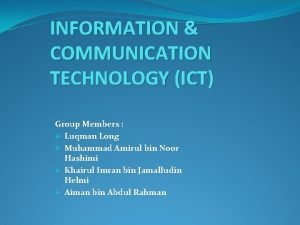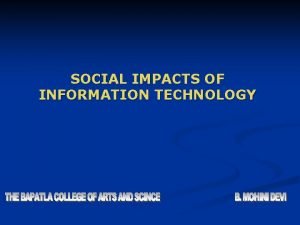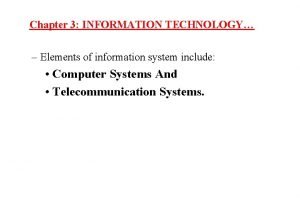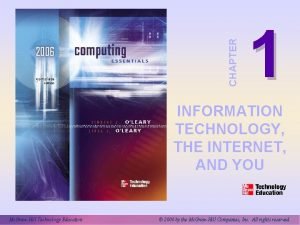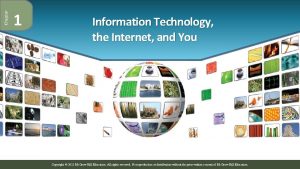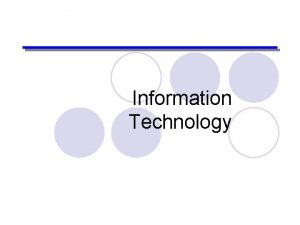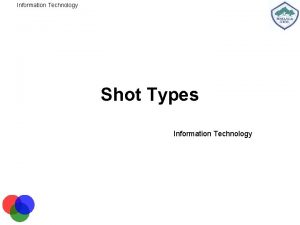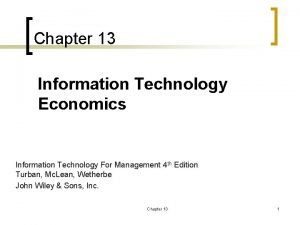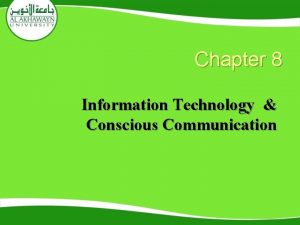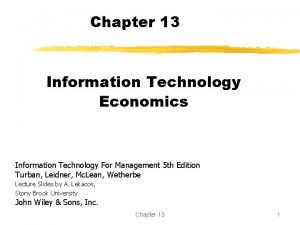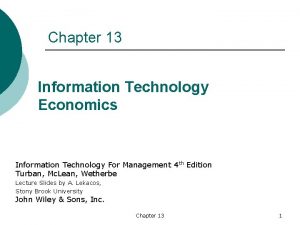Chapter 16 The Impacts of Information Technology on
















- Slides: 16

Chapter 16 The Impacts of Information Technology on Individuals, Organizations, and Society Information Technology For Management 5 th Edition Turban, Leidner, Mc. Lean, Wetherbe Lecture Slides by A. Lekacos, Stony Brook University John Wiley & Sons, Inc. Chapter 16 1

Learning Objectives • Describe some of the major impacts of information technology on individuals, organizations, and society. • Understand the changes that take place in the workplace and the lives of individuals when information technology eliminates geographical and spatial barriers. • Discuss the positive and negative effects associated with the abundance of information made available by IT. • Identify the issues that arise due to uneven diffusion of information technology across countries and socioeconomic classes. • Understand the complexity of effects of technological progress on labor markets and individual employees. • Discuss the impacts of information technology on the quality of life and interpersonal relationships. • Recognize the legal, ethical, and moral issues that become particularly critical due to proliferation Chapter 16 2

IT Positive Effects Only? We assume that organizations will reap the fruits of new technology and that computers have no major negative impact. But is this really true? • • • Will society have any control over the deployment of technology? Where will technology critics be able to make their voices heard? Who will investigate the costs and risks of technologies? What about health and safety issues? What impact will IT have on employment levels? What impact will IT have on the quality of life? Chapter 16 3

Impacts On Organizations The use of computers and information technology has brought many changes to organizations. • The manager’s job • Organizational structure, authority and power • Job content (Value and Supply Chain) • Employee career paths • Supervision Chapter 16 4

The Manager’s Job The most important task of managers is making decisions. IT changes the manner in which many decisions are made. • • • Automation of routine decisions Less expertise required for many decisions. More rapid identification of problems and opportunities Less reliance on experts to provide support to top executives. Empowerment of lower and middle levels of management. Decision making undertaken by non-managerial employees. Power redistribution among managers Thinner organizations. Organizational intelligence that is more timely, comprehensive, accurate, and available Chapter 16 5

Authority, Power, Job Content The IT revolution has resulted in many changes in structure, authority, power and job content. Chapter 16 6

Impact On Personnel Issues Many personnel-related questions arise as a result of using IT. Chapter 16 7

Impact On Individuals Information systems affect individuals in various ways. What is a benefit to one individual may be a constraint to another. • • Dehumanization and other psychological impacts Information anxiety Job stress Video display Radiation exposure Repetitive strain (stress) injuries Lack of proper Ergonomics Other Impacts … Chapter 16 8

Other Impact On Individuals Interactions between individuals and computers are numerous. Chapter 16 9

Impact Society IT has already had many direct beneficial effects on society, being used for complicated human and social problems such as medical diagnosis, computer assisted instruction, government-program planning, environmental quality control, and law enforcement. • Opportunities for people with disabilities • Quality of Life improvements • Improvements in health care • Crime fighting Benefits Chapter 16 10

Impact Society Use of IT has raised the issues of invasion of privacy. • Scanning crowds for criminals • Cookies and individual privacy • Digital millennium copyright act • Providing Social services • Possible massive unemployment resulting from the increased use of IT • The “digital divide” or gap between those who have technology and those who do not. • Impact of globalization on culture Chapter 16 Issues 11

Virtual Communities A virtual (Internet) community is one in which the interaction among group members that share a common interest takes place via the Internet rather than face-to-face. Types of Communities Chapter 16 12

Virtual Communities Virtual communities have commercial as well as social aspects. Financial Viability of Communities Chapter 16 13

MANAGERIAL ISSUES • The effects of offshore outsourcing. Offshore outsourcing may be either an • Managing and evaluating remote workers. Telecommuting increases the • Dealing with information overload. In many workplaces, the capacity of opportunity or a threat to an organization. To improve organizational efficiency, companies should explore the opportunities to outsource certain noncore activities to firms in other parts of the world. However, managers should be aware of various legal and ethical considerations surrounding this issue as well as the impact of outsourcing on the size and morale of their workforce. number of employees working away from the office. To manage these employees, it is vital to place a greater emphasis on regular formal communications. Effective performance evaluation is also different and requires a closer examination of the actual outputs produced by each employee. information systems to collect and generate information has outpaced the ability of human employees to absorb it. The resulting information overload negatively impacts employees and their productivity. A greater investment in knowledge management systems, decision support systems, and related tools may help to solve this problem. Chapter 16 14

MANAGERIAL ISSUES • Providing high-quality information. As companies continue to rely on • Displacement of employees with information technology. In any • Use of electronic surveillance. Proliferation of computer and white-collar crime increasingly larger volumes of information, the issue of information quality becomes critically important to the success of the organizations. Furthermore, recent laws, such as the Sarbanes–Oxley Act, make CEOs and CFOs personally liable for the quality and accuracy of financial information disclosed to the public. occupation—blue-collar, clerical, or white-collar—machines are acquiring the capabilities to perform “human” tasks more effectively and efficiently. Although this trend is unlikely to result in massive worldwide unemployment, it can have dramatic results on individual organizations and on individual employees. Thus, managers should be aware of the potentially disruptive technologies that may displace them or their colleagues and subordinates. impels employers to use information technology to monitor their employees. While electronic surveillance may reduce the incidence of unlawful activities, it may also result in employee resentment and other unintended consequences. Chapter 16 15

Chapter 16 Copyright © 2005 John Wiley & Sons, Inc. All rights reserved. Reproduction or translation of this work beyond that permitted in Section 117 of the 1976 United States Copyright Act without the express written permission of the copyright owner is unlawful. Request for further information should be addressed to the Permissions Department, John Wiley & Sons, Inc. The purchaser may make backup copies for his/her own use only and not for distribution or resale. The Publisher assumes no responsibility for errors, omissions, or damages, caused by the use of these programs or from the use of the information contained herein. Chapter 16 16
 Positive and negative impacts of materials technology
Positive and negative impacts of materials technology Negative impacts of environmental technology
Negative impacts of environmental technology Luqman long
Luqman long Social impacts of information technology
Social impacts of information technology Positive impacts of materials technology
Positive impacts of materials technology Positive and negative impacts of materials technology
Positive and negative impacts of materials technology Information technology chapter 3
Information technology chapter 3 Chapter 1 information technology the internet and you
Chapter 1 information technology the internet and you Chapter 1 information technology the internet and you
Chapter 1 information technology the internet and you Ecotourism advantages
Ecotourism advantages Social impacts of ict
Social impacts of ict Putting-out system
Putting-out system The role of the gaa in irish life
The role of the gaa in irish life Impacts of the haitian revolution
Impacts of the haitian revolution Negative social impacts of tourism
Negative social impacts of tourism Positive impacts of tourism in glasgow
Positive impacts of tourism in glasgow Consequences of inflation
Consequences of inflation


